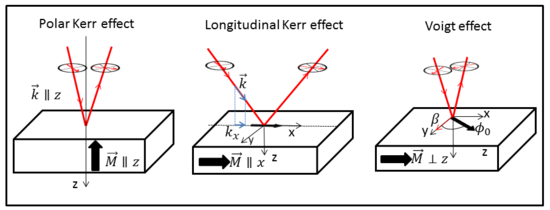
Back مفعول فويجت Arabic Efecte Voigt Catalan Voigt-Effekt German Efecto Voigt Spanish Effetto Voigt Italian Efeito de Voigt Portuguese Voigtov pojav Slovenian Voigt effekti Uzbek 福格特效应 Chinese

The Voigt effect is a magneto-optical phenomenon which rotates and elliptizes linearly polarised light sent into an optically active medium.[1] The effect is named after the German scientist Woldemar Voigt who discovered it in vapors. Unlike many other magneto-optical effects such as the Kerr or Faraday effect which are linearly proportional to the magnetization (or to the applied magnetic field for a non magnetized material), the Voigt effect is proportional to the square of the magnetization (or square of the magnetic field) and can be seen experimentally at normal incidence. There are also other denominations for this effect, used interchangeably in the modern scientific literature: the Cotton–Mouton effect (in reference to French scientists Aimé Cotton and Henri Mouton who discovered the same effect in liquids a few years later) and magnetic-linear birefringence, with the latter reflecting the physical meaning of the effect.
For an electromagnetic incident wave linearly polarized and an in-plane polarized sample , the expression of the rotation in reflection geometry is is: and in the transmission geometry: where is the difference of refraction indices depending on the Voigt parameter (same as for the Kerr effect), the material refraction indices and the parameter responsible of the Voigt effect and so proportional to the or in the case of a paramagnetic material.
Detailed calculation and an illustration are given in sections below.
- ^ Zvezdin, Anatoly Konstantinovich (1997), Taylor & Francis Group (ed.), Modern magneto-optics and magneto-optical materials : Studies in Condensed Matter, Taylor & Francis, Bibcode:1997mmmm.book.....Z, ISBN 978-0-7503-03620.



![{\displaystyle \delta \beta _{r}={\frac {2\Delta n}{n_{0}^{2}-1}}\sin[2(\phi -\beta )]}](https://wikimedia.org/api/rest_v1/media/math/render/svg/476e3a57e96af14a16e6b0f371aacb12d226c824)
![{\displaystyle \delta \beta _{t}={\frac {B_{1}+n_{0}^{2}{\Big [}{\frac {2L\omega }{c}}(1+n_{0})Q_{i}Q_{r}+Q_{r}^{2}-Q_{i}^{2}{\Big ]}}{n_{0}(1+n_{0})}},}](https://wikimedia.org/api/rest_v1/media/math/render/svg/3f66456edd0c9912fa6119d8f4319a2428449bb1)





